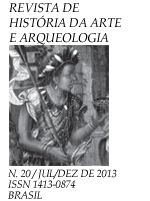Abstract
This article begins with the observation that the first paintings in which iconographic and compositional changes in the representations of the Last Judgement were made in Tuscany in the 1330s. Analysing the deteriorated cycle painted in the Cappella del Podestà, in Palazzo del Bargello, Florence, and also the frescoes of the Trionfo della Morte cycle, in Pisa’s Camposanto, some hypothesis are made regarding the iconography developed in both paintings of the Bargello cycle, and also regarding the importance of both Florentine and Pisan cycles for the development of the iconography of the Last Judgement in the second half of the 14th century and even in the 15th.
References
“Image et événement: l’art sans la peste (c. 1348- c. 1400)?”. In: La Peste Nera. Dati di una realtà ed elementi di una interpretazione. Atti del XXX Convegno storico internazionale. Spoleto: Centro Italiano di Studi sull’Alto Medioevo, 1994, p. 30.
BARTOLO, T. His life and work (tese de doutorado). Nova York: New York University, 1991, p. 793
BELLOSI, L. Buffalmacco e il trionfo della morte. Turim: Einaudi, 1974.
COHN, S. “Death and property in Siena, 1205-1800. Strategies for the after life. Baltimore e Londres, 1988; The cult of remembrance and the Black Death. Six Renaissance cities in central Italy. Baltimore e Londres: John Hopkins University, 1992; The Black Death transformed. Disease and culture in early Renaissance Europe.” Nova York: Oxford University, 2002
História (São Paulo)., v. 29, 2010; “A Peste Negra e a representação do Inferno em afrescos toscanos do século XIV”. In: Atas da VI Semana de Estudos Medievais. Rio de Janeiro: Programa de Estudos Medievais/UFRJ, 2006.
Les justices de l’au-delà. Les représentations de l’enfer en France et en Italie (XIIe -XVe siècle). Rome: École Française de Rome, 1993, p. 359.
MEISS, M. Painting in Florence and Siena after the Black Death. Princeton: Princeton University, 1964.
OFFNER, R. Bernardo Daddi and his circle. Florence: Giunti, 2001, p. 542.
PASSERINI, L. Del ritratto di Dante Alighieri che si vuole dipinto da Giotto nella Cappella del Potestà di Firenze. Florença: Cellini, 1865, p. 5
QUÍRICO, T. “Peste Negra e escatologia. Os efeitos da expectativa da morte sobre a religiosidade do século XIV”. In: Mirabilia, v. 14, janeiro-junho de 2012.
VASARI, G. Le vite dei più eccellenti pittori, scultori ed architetti, 3ª edição. Rome: Newton & Compton, 1997, p. 150.

This work is licensed under a Creative Commons Attribution 4.0 International License.
Copyright (c) 2021 Journal of Art History and Culture

